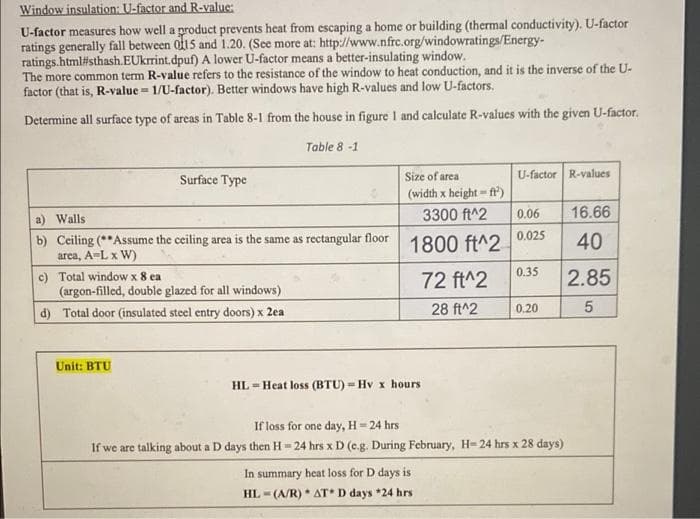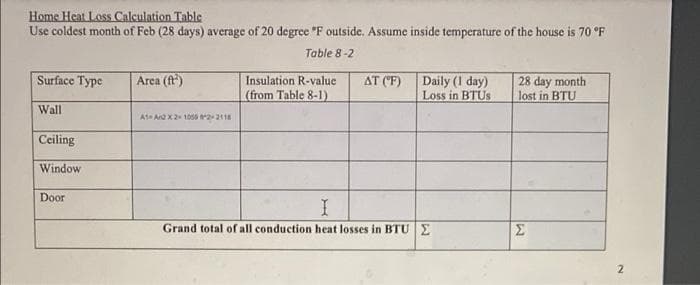1- If 1 gallon of oil = 1.4 therm, how many gallons have been wasted by heat loss in Feb? (1 therm = 100,000 BTU) 2- If $1.30 per therm, how much did you waste from house heat loss in Feb
1- If 1 gallon of oil = 1.4 therm, how many gallons have been wasted by heat loss in Feb? (1 therm = 100,000 BTU) 2- If $1.30 per therm, how much did you waste from house heat loss in Feb
Principles of Heat Transfer (Activate Learning with these NEW titles from Engineering!)
8th Edition
ISBN:9781305387102
Author:Kreith, Frank; Manglik, Raj M.
Publisher:Kreith, Frank; Manglik, Raj M.
Chapter11: Heat Transfer By Radiation
Section: Chapter Questions
Problem 11.17P
Related questions
Question
I need help with the second table.
and these questions
1- If 1 gallon of oil = 1.4 therm, how many gallons have been wasted by heat loss in Feb? (1 therm = 100,000 BTU)
2- If $1.30 per therm, how much did you waste from house heat loss in Feb?

Transcribed Image Text:Window insulation: U-factor and R-value:
U-factor measures how well a product prevents heat from escaping a home or building (thermal conductivity). U-factor
ratings generally fall between 0115 and 1.20. (See more at: http://www.nfrc.org/windowratings/Energy-
ratings.html#sthash.EUkrrint.dpuf) A lower U-factor means a better-insulating window.
The more common term R-value refers to the resistance of the window to heat conduction, and it is the inverse of the U-
factor (that is, R-value=1/U-factor). Better windows have high R-values and low U-factors.
Determine all surface type of areas in Table 8-1 from the house in figure 1 and calculate R-values with the given U-factor.
Surface Type
Walls
b) Ceiling (Assume the ceiling area is the same as rectangular floor
area, A-L x W)
c) Total window x 8 ea
(argon-filled, double glazed for all windows)
d) Total door (insulated steel entry doors) x 2ea
Unit: BTU
Table 8-1
Size of area
(width x height-ft³)
3300 ft^2
1800 ft^2
72 ft^2
28 ft^2
HL=Heat loss (BTU)- Hv x hours
=
In summary heat loss for D days is
HL (A/R) AT* D days *24 hrs
U-factor R-values
0.06
0.025
0.35
If loss for one day, H = 24 hrs
If we are talking about a D days then H-24 hrs x D (e.g. During February, H-24 hrs x 28 days)
0,20
16.66
40
2.85
5

Transcribed Image Text:Home Heat Loss Calculation Table
Use coldest month of Feb (28 days) average of 20 degree "F outside. Assume inside temperature of the house is 70 °F
Table 8-2
Surface Type
Wall
Ceiling
Window
Door
Area (ft³)
A1-An2 x 2-1059 2-2118
Insulation R-value
(from Table 8-1)
AT (°F)
Daily (1 day)
Loss in BTUS
I
Grand total of all conduction heat losses in BTU E
28 day month
lost in BTU
Σ
2
Expert Solution
This question has been solved!
Explore an expertly crafted, step-by-step solution for a thorough understanding of key concepts.
This is a popular solution!
Trending now
This is a popular solution!
Step by step
Solved in 2 steps with 2 images

Knowledge Booster
Learn more about
Need a deep-dive on the concept behind this application? Look no further. Learn more about this topic, mechanical-engineering and related others by exploring similar questions and additional content below.Recommended textbooks for you

Principles of Heat Transfer (Activate Learning wi…
Mechanical Engineering
ISBN:
9781305387102
Author:
Kreith, Frank; Manglik, Raj M.
Publisher:
Cengage Learning

Principles of Heat Transfer (Activate Learning wi…
Mechanical Engineering
ISBN:
9781305387102
Author:
Kreith, Frank; Manglik, Raj M.
Publisher:
Cengage Learning